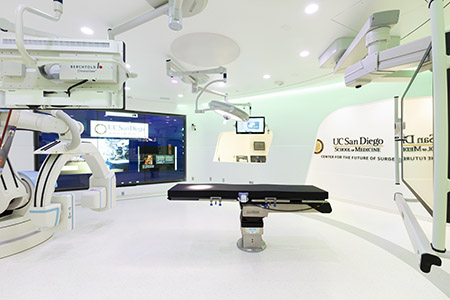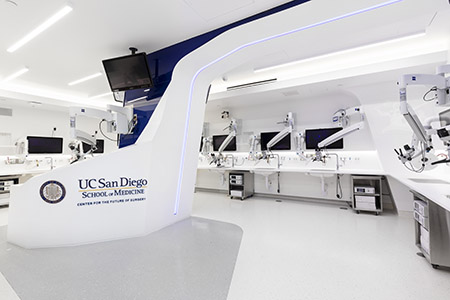Center for Future of Surgery Expands at UC San Diego School of Medicine
Futuristic simulation rooms advance surgical skills, patient safety and device innovation
Published Date
By:
- Jackie Carr
Share This:
Article Content
The ideal place to learn surgery is in an operating room — one without a patient. Welcome to the Center for the Future of Surgery (CFS) at University of California San Diego School of Medicine, one of the few facilities in the world dedicated to safely teaching surgery in high-tech simulated operating rooms. Here, surgeons refine their skills without risk to patients. In Fall 2019, UC San Diego School of Medicine expanded the center to address the newest surgical trends, especially those benefitting the brain and nervous system.
“The expansion of the Center for the Future of Surgery demonstrates UC San Diego’s continued and absolute commitment to patient safety,” said Santiago Horgan, MD, CFS director. “The Center offers surgeons of all specialties a rare opportunity to train on the newest techniques and technologies outside of a live operating room. This is where the next generation of surgeons is acquiring hands-on knowledge and experience to provide patients with the best, safest operations possible.”
Located inside the T. Denny Sanford Medical Education and Telemedicine Center, the 22,000 square-foot center has added two one-of-a-kind training spaces: a new hybrid operating room and a microsurgical suite. The new spaces allow for training in highly specialized areas, such as interventional endovascular surgery involving delicate procedures to stop brain hemorrhages, repair arteries, reconstruct facial nerves and restore hearing.
“The Center for the Future of Surgery is now the largest, most comprehensive training facility in the U.S.,” said Horgan, who also serves as chief of minimally invasive surgery at UC San Diego School of Medicine. “This is where we develop and evaluate new surgical techniques and devices with the ultimate goal of providing the highest level of care for patients — less pain, quicker recoveries and better outcomes.”
“The Center is an extraordinary space that gives surgeons — from residents to established surgeons — an opportunity to achieve their highest level of skill. The expansion, both in terms of the design of its physical space and implementation of technologies, reflects the emerging needs of surgeons, radiologists, cardiologists, and other experts,” said Bryan Clary, MD, surgery chair, UC San Diego School of Medicine. “The training rooms are designed with the newest imaging platforms and surgical instruments, including technologies so new they have not yet reached all U.S. hospitals.”

The hybrid operating training room represents a confluence of multiple technologies from intra-operative imaging to 3D scanning capabilities.
The hybrid operating room represents a confluence of multiple technologies from intraoperative imaging to 3D scanning capabilities. One wall of the room — the “wall of knowledge” — is paneled with an interactive computer touch screen as tall and wide as the room. It displays an array of integrated data sources, including medical records and CT and MRI scans. The high-fidelity space is designed to improve surgeons’ technical skills, psychomotor skills, hand-eye coordination and ambidextrous surgery.
“Learning anatomy and surgical procedures from textbooks only provides a limited benefit,” said Jeffrey P. Harris, MD, PhD, chief of otolaryngology/head and neck surgery, UC San Diego School of Medicine. “Since CFS uses real anatomical specimens, participants are able to understand three-dimensional anatomy so that when they treating real patients they have mastered the required techniques for successful outcomes.”
“In the microsurgical lab, for example, we demonstrate and practice the nuances of techniques, such as drill performance, light versus forceful pressures, preservation of brain structures and other critical movements that are needed for optimal surgical outcomes,” added Harris.
The hybrid OR and microsurgical suites will also be used by industry to develop new surgical techniques, approaches and procedures. CFS enables device development for implants, instrumentation and visualization technologies.
“There is a collaborative effort with industry partners to develop life-changing technologies that ultimately reach patients,” said Alexander Khalessi, MD, MBA, neurological surgery chair, UC San Diego Health. “It's important for industry to have a structured environment like CFS where they can access the expertise and feedback of our faculty. What's exciting about these partnerships is that you're able to see sensitive intellectual property at fairly early stages of development and provide input that leverages the distinct expertise and resources of UC San Diego’s biotech ecosystem. These technologies can be developed and tested at CFS, and then deployed at Jacobs Medical Center for the benefit of patients.”

Microsurgical lab at Center for Future of Surgery.
Since 2011, more than 20,000 surgeons from around the world have trained in more than 1,800 courses at CFS, which houses more than 22 surgical stations with options for robotic, endoscopic, laparoscopic, open and microscopic technologies.
The expansion of CFS is possible by the funding and support of UC San Diego School of Medicine as well as Stryker Corporation, Siemens Corporation, Zeiss International, Leica Biosystems and Integra LifeSciences.
For more information about the Center for the Future of Surgery, visit medschool.ucsd.edu/som/surgery/cfs, email cfs@ucsd.edu or call 858-246-1004.
Share This:
You May Also Like
Stay in the Know
Keep up with all the latest from UC San Diego. Subscribe to the newsletter today.



